Unknown calls may be stressful, particularly because of the increase in scams and spams in the Philippines. A reverse phone search can assist in letting you know the owner of a number, prior to calling. As of 2025, a number of tools can support Globe, Smart, TNT, DITO, landline, and VoIP numbers. This guide contains the most useful and trusted Philippine phone number lookup tools that have been tested using Filipino users.
How We Ranked Each Phone Number Lookup Tool
We rated every Philippines reverse phone lookup service depending on actual user experiences, data precision, and reliability. All the number lookup Philippines tools were verified with the help of local mobile and landline numbers.
- Accuracy of PH phone number
We rated the degree to which each tool is similar to a number to the rightful owner or identity. Tools that had confirmed databases and had a regular match quality were ranked higher.
- Coverage of Globe, Smart, TNT, DITO, landline & VoIP numbers
We tried every location using the numbers of major PH carriers to determine the breadth of their coverage. Those tools that identified VoIP and landline numbers earned additional points.
- Data available
We confirmed the information that each tool gives out: name, spam score, location, or carrier information. Greater elaboration of insights resulted in increased rankings.
- Ease of use
We tested the ease of use of the site or application when making a lookup. Easy outlines and fast outcomes enhanced the score of every tool.
- Free vs paid features
We contrasted the amount of data available as a free or premium upgrade. Tools that provide the necessary information freely were rated higher.
- Extra features
Spam reporting, call blocking and fraud detection were taken into account. Bonus points were earned by the tools with a higher value added to them.
Top 7 Best Philippines Reverse Phone Lookup
Not every lookup tool is effective in the Philippines. Some displays minimal carrier information and others give detailed information about the owners. These are the seven best tools that would survive our 2025 tests, in terms of accuracy, features and usability.
LocatePhone
Philippines reverse phone lookup by LocatePhone lets you instantly identify who is behind any mobile or landline number. The tool scans public records, telecom data, and online profiles to reveal the caller’s name, address, carrier, and location. It also checks updated databases for accurate, real-time results.
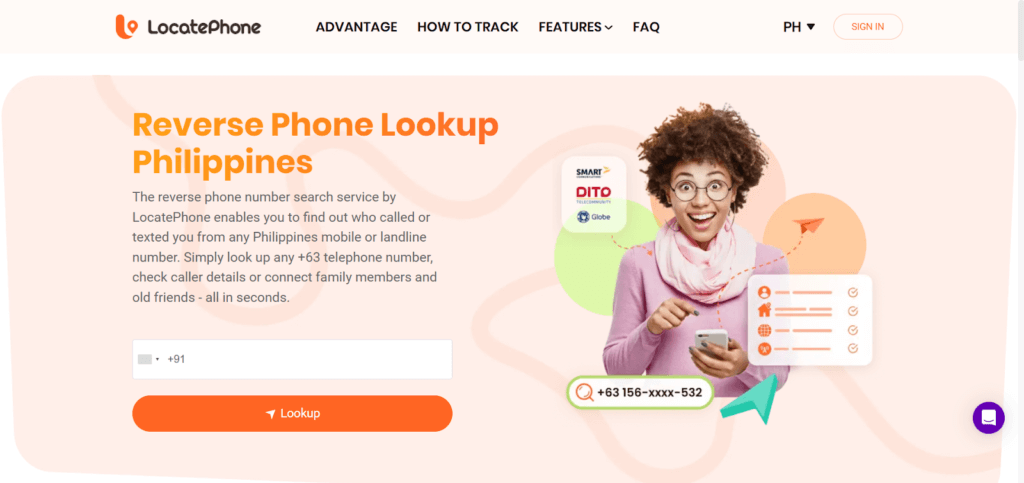
Built for simplicity and privacy, LocatePhone ensures secure searches, helping you reconnect with people, verify unknown callers, and avoid potential scams with confidence.
Key Features:
- Scans telecom, public records, and social media-linked data
- Provides name, address, carrier, and online profile details
- Real-time, accurate, updated database for PH numbers
Pros:
- Highly accurate for both mobile and landline numbers
- Private and secure lookups with no alerts sent to the owner
- Fast results with detailed breakdown of available records
Cons:
- Not free; full details require a premium account
- Requires an email to receive report results
- May have limited data on very new or inactive numbers
Truecaller
Truecaller is a widely trusted global app for identifying unknown callers, including those from the Philippines. It uses a huge community-powered database, where Filipino users help flag spam, scam, and telemarketing numbers. Its reverse phone lookup feature lets you quickly search registered mobile numbers and view caller names or tags. Truecaller excels with mobile contacts, offering instant detection and spam protection, though accuracy may be limited for landline numbers in the Philippines.
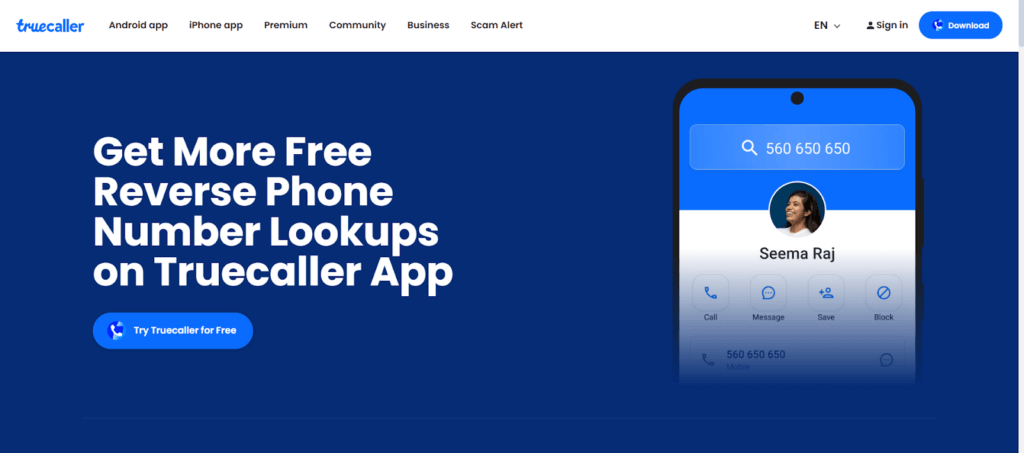
Key Features:
- Community-powered spam identification
- Quick lookup for caller names and tags
- Integrated call-blocking and spam protection
Pros:
- Excellent for spotting scam and spam numbers
- Large Filipino user base improves accuracy
- Free to use basic lookup features
Cons:
- Limited accuracy for PH landline numbers
- Results depend heavily on user-generated data
- Requires sign-in and app permissions
ThisNumber
ThisNumber specializes in public directory information to search Philippines telephone numbers and mobile numbers. It gathers data from various telecom directories and user reports. The site offers simple number searches with basic metadata such as line type and region. It’s useful for identifying older landline numbers and VOIP lines registered in PH.
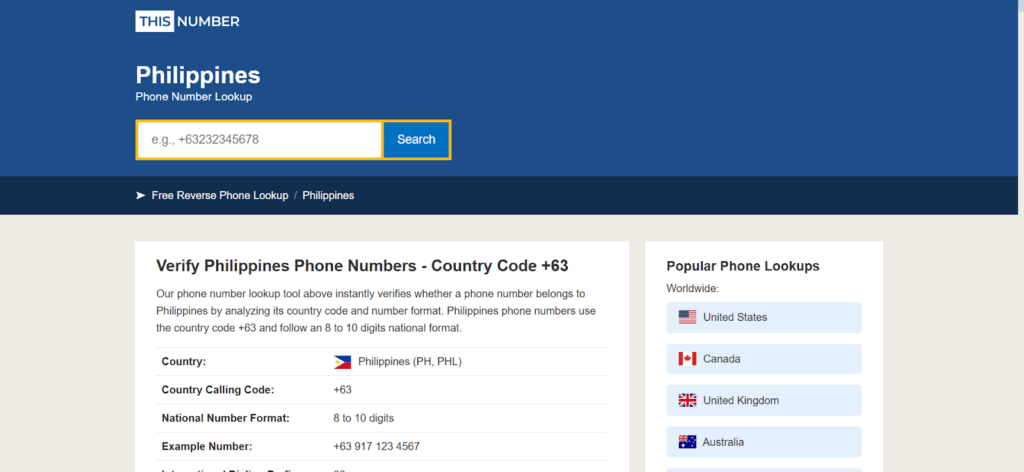
Key Features:
- Simple directory-based phone number search
- Identifies region, line type, and basic metadata
- Shows user comments and shared experiences
Pros:
- Ideal for tracking landline numbers
- Quick and lightweight site without login
- Helpful user comment section for context
Cons:
- Limited owner details (no name or address)
- Not very accurate for mobile numbers
- Mostly dependent on public directory data
IPQS
IPQS is best known for fraud scoring and phone validation. It checks whether a number is active, risky, or linked to scams. The tool works for Globe, Smart, TNT, DITO, and VoIP numbers. It provides detailed metadata such as line type, activity status, and risk score, ideal for business verification.
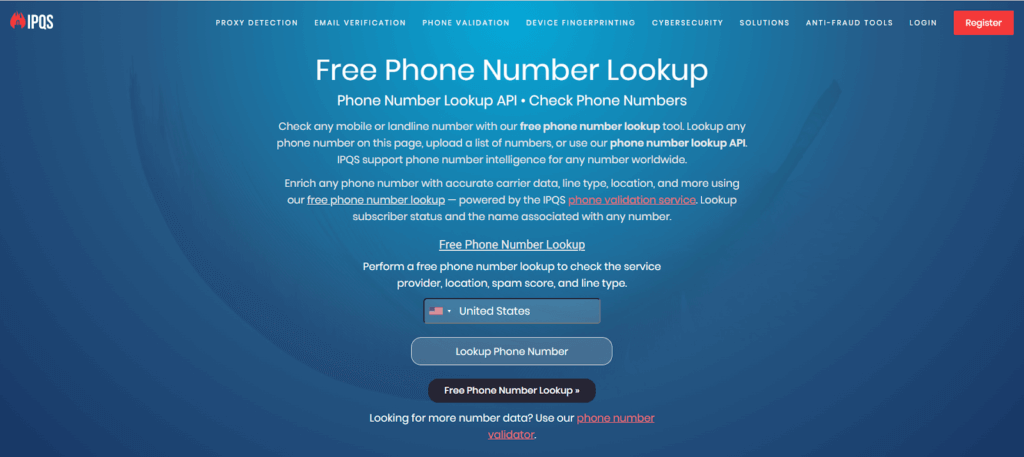
Key Features:
- Provides detailed fraud and risk scoring
- Detects active numbers, line types, and carrier data
- Checks whether a number is linked to scams or VoIP services
Pros:
- Highly accurate for scam and fraud detection
- Ideal for business verification and screening
- Supports all major PH networks
Cons:
- Does not show owner names or address details
- More technical and business-oriented
- Some detailed results require paid credits
KrispCall
KrispCall is targeted at companies that desire quick search and identification of callers. It gives information on carrier, location and the type of line in PH numbers. The interface is easy and the results are displayed immediately. KrispCall is also compatible with virtual phone system, which makes it beneficial in authenticating customer or client calls.

Key Features:
- Instant carrier and line-type identification
- Works with virtual phone system integrations
- Provides basic location and telecom metadata
Pros:
- Clean, easy-to-understand interface
- Reliable for business communication verification
- Supports mobile, landline, and VoIP numbers
Cons:
- No owner name or social profile information
- Primarily business-focused, less consumer-friendly
- Limited depth compared to full people-search tools
Tellows
Tellows is a Philippine-based spam reporting service. It concentrates on ranking unfamiliar calls based on reports of users. The site assists in tracking down telemarketers, fraudulent attempts, and spam calls. It also offers categories of caller types. It is best to identify possible fraud by reading previous complaints.
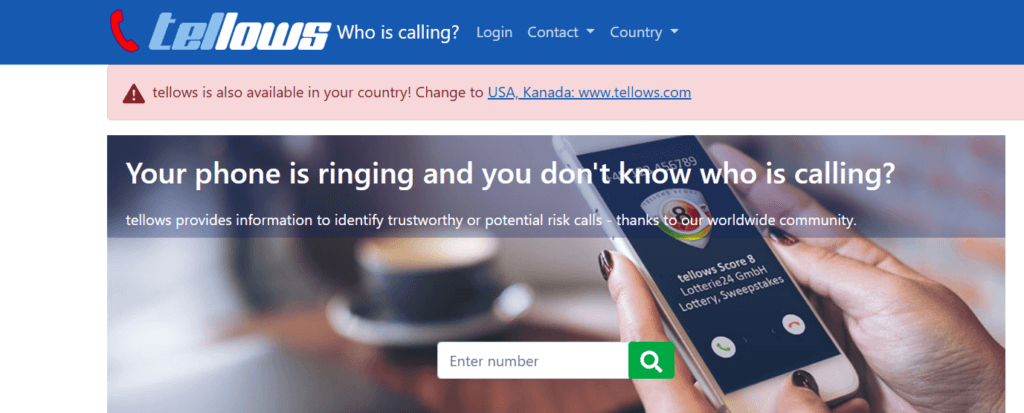
Key Features:
- Community-driven spam and fraud detection
- Caller scoring system for quick risk evaluation
- Detailed reports and user-generated comments
Pros:
- Very effective for identifying scammers and telemarketers
- Free to use with large PH community activity
- Useful caller categories such as “Debt Collector,” “Scam,” “Survey Call”
Cons:
- Does not reveal caller names or personal information
- Accuracy depends on user reports
- Limited for legitimate caller identification
Cellphone Location
The Philippines reverse phone lookup tool at Cellphone Location assists you in identifying unknown callers using real-time and correct data. It searches through various telecom, public, and online databases to unmask the owner of a phone number, location, carrier, and associated online profiles.

The tool also indicates suspicious, spam, or VoIP numbers, which will help you stay out of scams and unnecessary calls. It is user-friendly to the Filipino users, quick, informative, and verifies the number in the most secure manner.
Key Features:
- Scans telecom, public, and online records
- Shows owner name, carrier, and general location
- Flags spam, VoIP, and suspicious numbers
Pros:
- User-friendly and fast for Filipino users
- Provides more detailed data than basic lookup tools
- Helps avoid scam and phishing attempts
Cons:
- Full reports are not free
- Do not provide deeper background information
- Data may vary for unregistered or inactive numbers
Quick Look at the Philippine Phone Number Lookup
Here’s a quick comparison of the best Philippines reverse phone lookup tools. This table shows which tool is best for your needs and their pricing levels.
| Tool | Best For | Pricing |
| LocatePhone | Fast lookups & PH coverage | Paid |
| Truecaller | Spam detection & identity | Free + Paid |
| ThisNumber | Landline & VoIP checks | Free |
| IPQS | Fraud scoring & validation | Free + Paid |
| KrispCall | Business verification | Free |
| Tellows | Spam reporting & complaints | Free |
| Cellphone Location | Basic number info | Paid |
Are Philippines phone numbers harder to identify?
Yes, it can be hard to locate PH numbers, which are used by a number of carriers and are highly prepaid. There are a number of factors that result in less consistency of data as compared to other countries.
- Prepaid SIM culture
Many Filipinos use prepaid SIMs that are simple to purchase and change. This lowers the traceability since numbers tend to change owners, hence reverse lookups are less credible.
- SIM registration law (2023–2025 changes)
Even though SIM registration has become mandatory, the level of compliance is mixed. Many users continue to use unregistered or incorrectly validated SIMs, leaving gaps in the identification data of the lookup sites.
✔🔎Read Also: How to Check SIM Owner Name with Mobile Number in the Philippines?
- VoIP services mimicking PH area codes
VoIP numbers used by scammers are pretending to be actual PH prefixes. These numbers are more difficult to follow and the lookup tools cannot easily verify true identity or the location of the caller when this is done over the internet.
Other Ways to Search Philippine Telephone Numbers
If reverse lookup tools don’t give enough information, there are other ways to check who owns a PH number. These methods are free and commonly used by Filipino users.
WhatsApp profile check
WhatsApp is one of the fastest ways to identify a Filipino number because many users link their accounts with real names and profile photos. When you add a number to WhatsApp, it may show a display name, business tag, or profile picture. This makes it helpful for identifying unknown callers. However, it won’t show information if the user has strict privacy settings.
Steps:
- Save the phone number to your contacts on your phone.
- Open WhatsApp and allow the app to refresh your contact list.

- Search or open the saved contact in WhatsApp.
- Check the contact’s display name, profile photo, business tag, or status for identifying details.
Google search Philippines number
Google can reveal digital footprints connected to a PH phone number. Some numbers appear in forums, job listings, marketplace posts, scam reports, or business directories. Searching the number with quotes helps find exact matches. While results vary, Google is useful for uncovering online activity linked to a phone number.
Steps:
- Open Google and type the full phone number into the search bar.
- Put the number in quotation marks to force an exact-match search.

- Look through forum posts, marketplace listings, job ads, and directory results for matches.
- Check spam-report and complaint sites in the results to see if others flagged the number.
Carrier lookup for SIM type identification
Carrier lookup lets you check if the number belongs to Globe, Smart, TNT, or DITO. It also shows line type—mobile, VoIP, or landline. This helps you confirm whether a number looks suspicious. Many carrier lookup sites and apps offer instant SIM type identification without requiring registration.
Steps:
- Visit a carrier lookup or SIM identification website or app.
- Enter the full phone number into the tool’s search field.
- Click the search or submit button to run the lookup.
- Read the returned information to see the reported carrier, prefix details, and whether the line is mobile, VoIP, or landline.
FAQ
How to check the number owner name?
Use tools like Truecaller, Tellows, or WhatsApp. These platforms show user-submitted names, spam tags, or profile details. However, accuracy may vary depending on privacy settings and data availability.
How do I check who called me?
Use Truecaller or Tellows to view community reports. If the number is saved on messaging apps, check profile details. You can also search it on Google or lookup websites.
How to know NTC number owner name?
NTC does not publicly reveal owner names for privacy reasons. Use lookup tools, spam-report sites, or messaging apps to gather available public information.
Conclusion
Reverse phone lookup tools help Filipino users stay safe from scams and unknown callers. In 2025, several free websites now support Globe, Smart, TNT, DITO, VoIP, and landline numbers. Combining these tools with WhatsApp and Google searches gives you the best chance of identifying who’s calling.